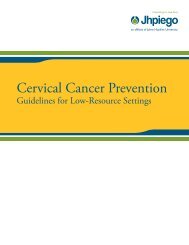Manual for Male Circumcision under Local Anaesthesia
Manual for Male Circumcision under Local Anaesthesia
Manual for Male Circumcision under Local Anaesthesia
Create successful ePaper yourself
Turn your PDF publications into a flip-book with our unique Google optimized e-Paper software.
<strong>Male</strong> circumcision <strong>under</strong> local anaesthesia<br />
Version 3.1 (Dec09)<br />
STANDARD PRECAUTIONS<br />
Standard precautions are a set of practices to prevent and control infection.<br />
They include the use of personal protective equipment, designed to protect<br />
health care workers and patients from contact with infectious agents.<br />
Laboratory and health care workers can protect themselves and their patients<br />
from exposure to HIV and other infections by following standard precautions.<br />
Often, during clinical care, it is not known whether a patient is infected or<br />
colonized with potentially pathogenic microorganisms. Every patient, and<br />
every member of staff, should there<strong>for</strong>e be considered at risk, both of<br />
infecting others and of acquiring an infection. Standard precautions should be<br />
applied during all contact between health care workers and patients, in all<br />
health care facilities at all times.<br />
The key components of standard precautions are:<br />
• hand washing and antisepsis (hand hygiene);<br />
• use of personal protective equipment when handling blood, blood<br />
products, body fluids or excretions, mucous membranes, non-intact<br />
skin, or wound dressings;<br />
• prevention of needle-stick and sharp injuries;<br />
• appropriate handling of patient care equipment, environmental<br />
cleaning and management of spills;<br />
• appropriate handling of waste.<br />
Each of these components is discussed in detail below.<br />
HAND HYGIENE<br />
Hand hygiene is the single most important and cost-effective measure to<br />
eliminate disease-causing microorganisms that contaminate hands, and to<br />
limit the spread of infection. Proper hand hygiene can be accomplished by<br />
frequent hand washing and frequent use of an alcohol-based handrub.<br />
In most clinical situations, an alcohol-based handrub should be used <strong>for</strong><br />
routine hand antisepsis. Commercial handrubs, liquid soaps and skin-care<br />
products are sold in disposable containers, and may be used provided they<br />
meet recognized international standards (such as those of the American<br />
Society <strong>for</strong> Testing and Materials or the European Committee <strong>for</strong><br />
Standardization), and are well accepted by health care workers. Where such<br />
products are not available or are too costly, an alcohol-based handrub can be<br />
produced locally at low cost. 2<br />
Prevention of Infection Chapter 8-3
















